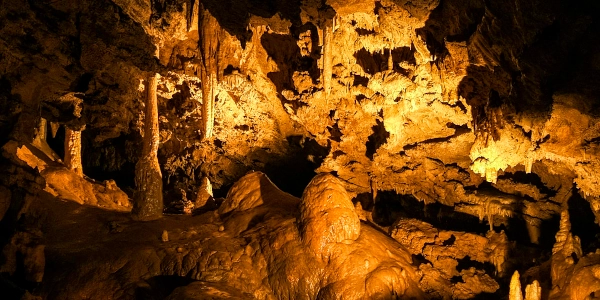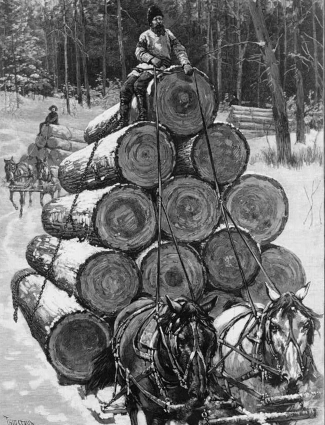
Image above: Drawing of a Wisconsin logging sled, 1885, Thure DeThulstrup. Courtesy Library of Congress.
Spotlight on Lesser Known History
Paul Bunyan Museum, Wisconsin
America's Best History Spotlight
On this page we're going to Spotlight the lesser known historic sites and attractions that dot the history landscape across the USA and are worth a visit if you're in their area. And while they may be lesser known, some are very unique, and will be that rare find. You'll be, at times, on the ground floor, or maybe even know something others don't. It'll be fun. Visit them.
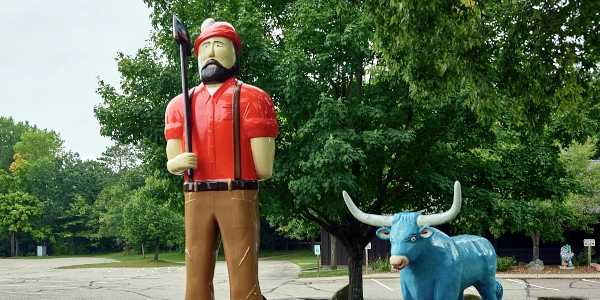
Paul Bunyan Logging Camp Museum, Wisconsin
It's now called the Wisconsin Logging Museum, to thwart the criticism, but no matter the name, the logging museum reflects the exploits of the fabled Paul Bunyan and the rest of the loggers who toiled in the woods of Wisconsin and especially the Chippewa Valley. At one time this area timbered more lumber than any other in the United States.
It became apparent to the first European settlers that the dense woodland of Wisconsin would not support agriculture in the ways of other territories, so lumbering became the predominant industry. It was first central on the Wisconsin River with sawmills in Wausau and Stevens Point. There were two other major areas; along the Wolf River, and along the Chippewa and Black Rivers. In the early days, much of the lumbering was done by immigrants from Scandinavia.
Photo above: Statue of Paul Bunyan, which was created by Phil Nessel and students from Eau Claire North High School. Statue of Ox Babe was rehabilitated from an original, 2016, Carol M. Highsmith. Courtesy Library of Congress.
Sponsor this page for $100 per year. Your banner or text ad can fill the space above.
Click here to Sponsor the page and how to reserve your ad.
Info, What's There Now, History Nearby
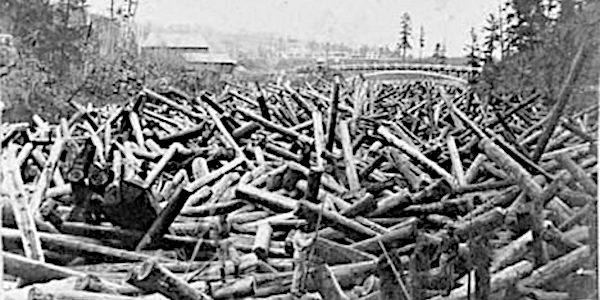
Paul Bunyan Logging Camp Museum, Wisconsin
Today, the museum, visitor center, and four historic buildings tell the stories of the lumber industry, Paul Bunyan, his ox Babe, and the men and women who worked the timber. If you're in Wisconsin, take a look at one of the lesser known museums; you might even take in a baseball game along the way. See more on that below.
Image above: St. Croix River logjam, 1865, Minnesota Historical Society. Courtesy Wikipedia Commons. Below: Montage: (left) Paul Bunyan statue in wood and sign at the Paul Bunyan Logging Camp, Wisconsin Logging Museum entrance, 2016, Carol M. Highsmith. (right) Fur Coat on display at the Paul Bunyan Logging Camp Museum, 2016, Carol M. Highsmith. Both Courtesy Library of Congress.
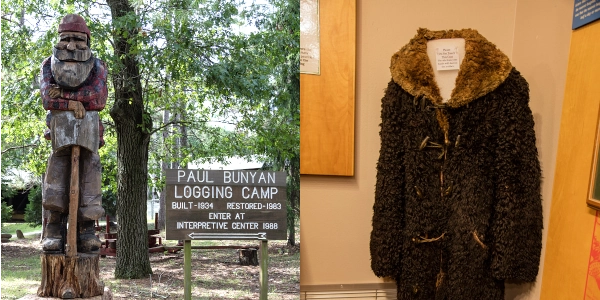
Where Is It
The Paul Bunyan Logging Camp Museum, now called the Wisconsin Logging Museum, is located in Carson Park, 1110 E Half Moon Drive, Eau Claire, WI 54703.
What is There Now
Paul Bunyan Logging Camp Museum
A visitor center with exhibit center, four historic buildings, the huge Paul Bunyan and Babe statue, and biannual chainsaw competitions where more than one hundred chainsaw sculptures are created over four days. It is now technically called the Wisconsin Logging Museum, but we like adding the Paul Bunyan Logging Camp Museum better, even though the name change was done in 2019 to reflect their growing exhibits on the entire Wisconsin logging industry and not the tale. Parking is free. Picnic tables are available. There is a gift shop. The U.S. Open Chainsaw Sculpture Competition is being held in 2023 from August 10-13, 2023.
When Open and How Much
The museum and visitor center are open June to September. Opening date in 2023 is May 30 at 5:00 p.m. Generally open Tuesday 5:00 to 8:00 p.m. and Wednesday to Sunday 12 p.m. to 5 p.m. There is a charge of $12 for adults and $5 for children over 5. There is also a combination ticket with the Chippewa Valley Museum available.
Fees and hours are subject to change.
Websites
Paul Bunyan Logging Camp Museum
Eau Claire Visitor Center
History Nearby
There are a myriad of historic and natural sites to see in Wisconsin and the upper midwest. From National Park Service sites like the Apostle Islands, the St. Croix National Scenic Riverway, and Sleeping Bear Dunes National Lakeshore to smaller Eau Claire sites such as Farmers Markets, Leinie Lodge, and the Eau Claire Children's Museum.
Photos, History, and More Spotlights

Paul Bunyan Museum History
It's been around for over eighty years, begun in 1931 by Dr. Roy E. Mitchell and Dr. E.C. Mitchell, who wanted to keep the logging history of the Chippewa Valley alive. It had, at one time, provided more timber than anywhere else in the United States. It took three years to build a bunkhouse and cook house, then opened to the public in 1934. It was given to the city of Eau Claire and has been running and added to; tool shed, blacksmith shop, machine shed, since, now located in Carson Park.
Photo above: Exhibit in the museum of a period logging stamp, which denoted ownership of Northwood logs, 2016, Carol M. Highsmith. Courtesy Library of Congress.

T-Shirts and Gifts from the official souvenirs of Americasbesthistory.com.

Legend of Paul Bunyan
Although it is but folklore the tales of Paul Bunyan and his companion Babe the Ox, the story was passed down in logging camps about his heroic feats for thirty years, then written down by William B. Laughead in 1916 for a promotional pamphlet of the Red River Lumber Company. Statues of Paul Bunyan rise above many places in North America, not only in Eau Claire, Wisconson. And the newspaper stories, comic books, books, television adaptations, and more continue to be told to this day, with many an adaptation.
Photo above: Logs below bridge, likely the Chippewa Railroad Bridge, with town in distance, 1870/1880, J.B. Gallaher. Courtesy Library of Congress.
Buy Second Edition
America's Best History Timeline

Great book to keep your youngsters up to date on their history.

Carson Park
The museum and other recreation facilities are all located in Carson Park, which was given to the city by lumber baron William Carson in 1914. A baseball stadium was built there, hosting games from high school to the minor leages. Its history reaches back to 1936 when it was built by the Works Progress Administration. The stadium now hosts a collegiate wood bat league team, the Eau Claire Express, of the Northwoods League. Even more impressive to us, is that at one time it hosted the Eau Claire Bears. It was a true minor league team whose first game was held on May 4, 1937 against the Superior Blues.
Hold on to your hats. Players for the later team associated with the Milwaukee Braves, 1946, now known as the Eau Claire Braves, included Hall of Famers Joe Torre and Hank Aaron. Yes, hammering Hank. Other prominent players were famous broadcaster and player Bob Uecker, Wes Covington, and Andy Paftko. A monument to Hank Aaron sits in front of the stadium. Hank Aaron played there in 1952 and batted 0.336.
Carson Park includes one hundred and thirty-four acres on Half Moon Lake, at one time part of the old course of the Chippewa River. It also includes a football stadium used by the University of Wisconsin - Eau Claire Blugolds, and a second museum, the Chippewa Valley Museum.
Photo above: Carson Park Baseball Stadium with monument to former minor league player Henry Aaron, 2012, Royalbroil. Courtesy Wikipedia Commons C.C. 3.0.
About
America's Best History where we take a look at the timeline of American History and the historic sites and national parks that hold that history within their lands.
Photos courtesy of the Library of Congress, National Archives, National Park Service, americasbesthistory.com and its licensors.
- Contact Us
- About
- © 2023 Americasbesthistory.com.
Template by w3layouts.


